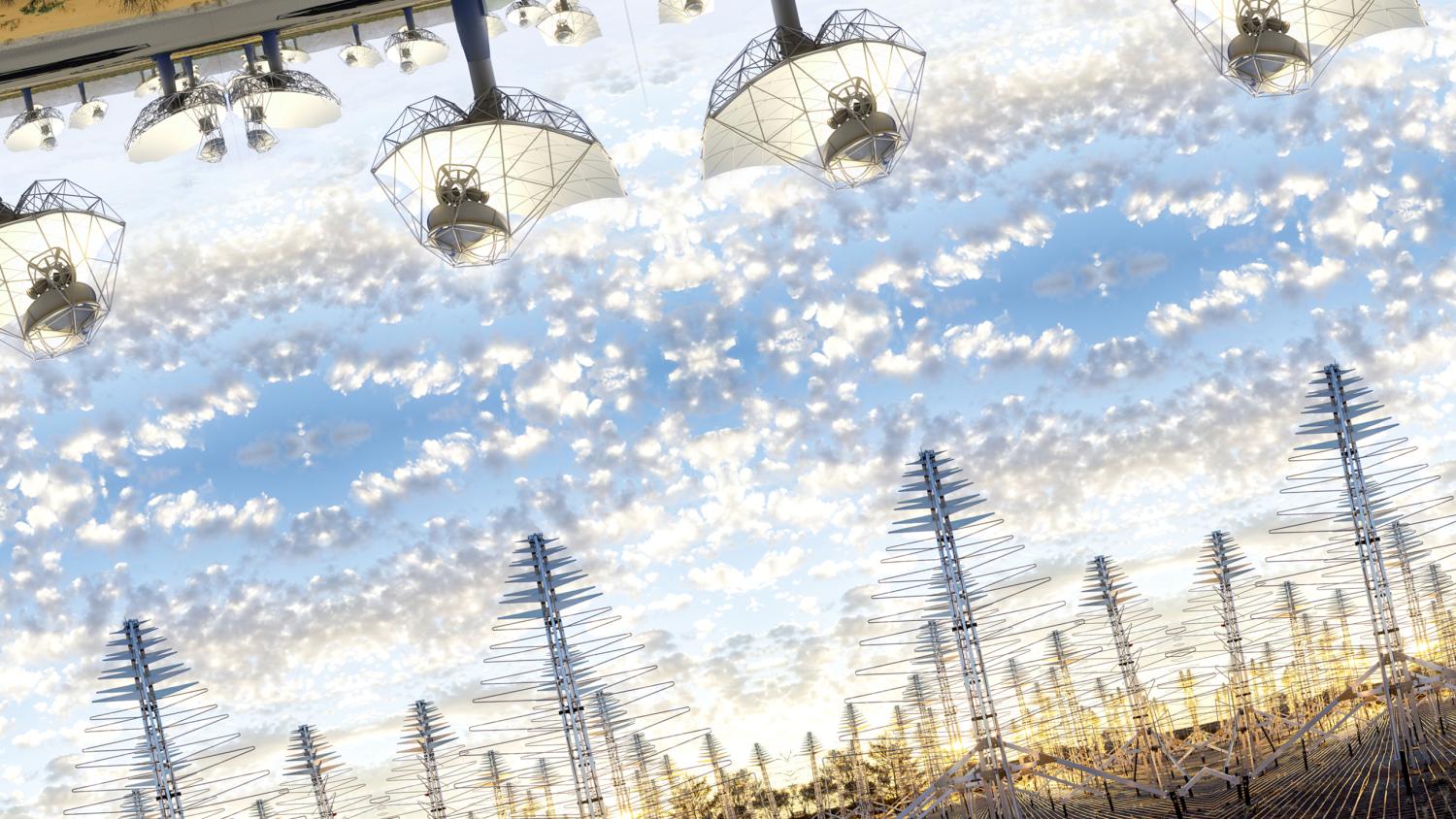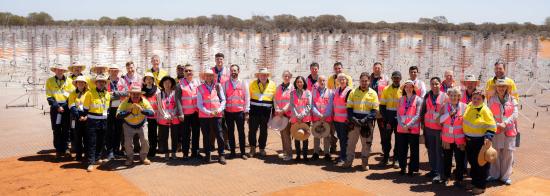Italy
At a glance
- Italy secured several key contracts between 2022 and 2023: the production of thousands of SKA-Low antennas, developing the Signal Processing Sub-system (SPS), and manufacturing feed indexers for SKA-Mid. Other tenders were awarded directly to INAF. The return on investment in Italy is worth around €50m.
- Italy has one of the SKA project's largest and most active scientific and radio astronomy communities. Through INAF and several universities, Italian researchers are actively involved in all SKA Science Working Groups, often in leadership roles. Since the early phases of SKA development, INAF has contributed to antenna design, signal processing, control software, and phased array feeds.
- INAF sits in the SKAO Council on behalf of the Ministry of University and Research and the Ministry of Foreign Affairs and International Cooperation.
- INAF operates four radio telescopes in Italy: the 64-m Sardinia Radio Telescope (SRT), the Northern Cross interferometer, and two 32-m parabolic antennas. The Northern Cross in Medicina (Bologna) also served as a testbed for the SKA precursor program BEST (Basic Element for SKA Training).
- Italy contributes to SKA-related science using precursors and pathfinders (ASKAP, LOFAR, and MeerKAT). INAF joined the International LOFAR Telescope in 2018 and the MeerKAT+ project in 2020. In addition, INAF has secured significant funding under the National Recovery and Resilience Plan (PNRR) to provide Band 5b receivers for MeerKAT.
National involvement
Italy has a longstanding tradition in radio astronomy and, through INAF, has been involved in the SKA project from the outset, joining it in 2000 during a meeting of the International Astronomical Union in Manchester. In 2011, Italy reaffirmed its commitment by signing a letter of intent in Rome, at INAF HQ, which led to the foundation of the SKA Organisation, the interim governing body towards the IGO.
Between 2015 and 2018, Italy led the negotiations that established the SKA Observatory as an intergovernmental organisation. On 24 May 2018, Italy was the first country to initial the SKAO Convention; the treaty was formally signed in Rome on 12 March 2019 by representatives of Australia, China, Italy, the Netherlands, Portugal, South Africa and the UK. Italy became the second country to ratify the SKAO Convention in February 2020. Also in 2019, Italy secured funding for the SKA project through the Ministry of Foreign Affairs and International Cooperation. SKAO construction officially began on 1 July 2021, when Italian companies were awarded the first set of procurement contracts.
Italy has played a key role in SKA design, and it is set to play an increasingly prominent role from a scientific point of view as the project progresses. INAF is establishing a dedicated data analysis facility that will join the SKA Regional Centres (SRC) network, an alliance of data centres that will host cutting-edge IT infrastructures capable of processing and storing the massive volume of data produced by the SKA telescopes. The SRCs will also provide SKA users with proposal preparation and data management support.

Industrial participation
INAF and its partners collaborate with many Italian companies to build SKA-Low antennas and SKA-Mid components. Between 2022 and 2023, Italy secured several major contracts with SKAO, resulting in several million Euros above the guaranteed threshold of €42m.
- At the end of 2022, SIRIO Antenne won the tender to manufacture the first 78,000 low-frequency antennas in Western Australia, with deployment starting in March 2024.
- In 2023, the Elemaster Group was awarded a contract to design and build the complex Signal Processing Sub-system (SPS) for SKA-Low. This system digitises, correlates, and processes radio signals before transmission to a remote supercomputer. Elemaster collaborates with Sanitas EG SRL, EES SPA, and CR&C SRL.
- Società Aerospaziale Mediterranea (SAM) is producing the first 64 feed indexers for SKA-Mid dishes, key electromechanical parts that position the receivers.
- Additional contracts were awarded directly to INAF, including work on the Observation Management and Control (OMC) software and the SKA-Low Station Management and Integration PSSC.
Science interests
Italian researchers and scientists, through INAF, contribute to the discussions and refinement of all the SKA project’s scientific cases thanks to broad participation in the SKA Science Working Groups (SWGs). Italy has one of the SKA collaboration's largest and most active communities. Researchers from INAF and Italian universities are involved in all 14 SKA Science Working Groups, and have served as co-chairs in 10 of them. Currently, they co-chair the Cradle of Life, Extragalactic Spectral Line Science, Gravitational Waves, and Pulsars working groups.
Furthermore, INAF researchers actively utilise the SKA precursors and pathfinders and lead numerous SKA-related scientific studies regularly published in major international journals, including Nature and Science. Italy-based researchers also secure competitive funding for SKA-driven projects, including ERC and FIS grants.
INAF organises a National Workshop dedicated to the SKA project every two years, offering a platform for Italy-based researchers to present results and foster collaboration. These workshops typically attract 120–150 participants per edition; the fifth edition will take place in Bologna in November 2025.
Technological interest
Since starting the SKA project, INAF has contributed to its technological development through European research programmes. During the design phase of the telescopes, INAF was part of four international consortia working on all key SKA components. INAF focused on designing low-frequency antennas, receivers, and signal acquisition systems for SKA-Low in Western Australia, in collaboration with the Universities of Bologna, Florence, Ferrara, and CNR-IEIIT. It also contributed to software for monitoring and controlling SKA-Mid dishes in South Africa, data processing algorithms, and phased array feed (PAF) receivers.
INAF developed two small-aperture demonstrators — MAD and SAD — to test low-frequency array technologies. This experience supported Italian engineers in building demonstrators at CSIRO’s Murchison Radio Astronomy Observatory. INAF-led teams also tested different antenna designs, including SKALA 4.1AL, which was selected for SKA-Low. Many of these R&D efforts continue today, in some cases under direct SKAO contracts, sustaining Italy’s strong technical role in the project.
Wider impact
To fully exploit the SKA capabilities, INAF is developing a dedicated data analysis facility that will join the SKA Regional Centres network: a distributed network of data centres housing high-end computing facilities for data processing and long-term archiving. This investment will also benefit broader scientific communities.
INAF regularly offers SKA-related research positions and funds SKA-related PhD and postdoc positions, fostering the next generation of scientists. Researchers actively promote SKA at scientific conferences, building collaborations across disciplines.
Public engagement plays a central role: the "Time Machines" exhibition showcased the SKA project as the future of radio astronomy, attracting over 80,000 visitors in two years. INAF hosts regular SKA-themed events at radio astronomical visitor centres. Media interest remains high: the 2022 Construction Commencement Ceremonies and the 2025 first SKA-Low image drew significant press coverage, especially on TV, reflecting broad public enthusiasm for the project. These activities underscore Italy’s scientific leadership and commitment to outreach, training, and interdisciplinary collaboration in the SKA era.
Contact
Communications & Media relations: Eleonora Ferroni (INAF) eleonora.ferroni@inaf.it
Outreach & Education: Daria Guidetti (INAF) daria.guidetti@inaf.it







